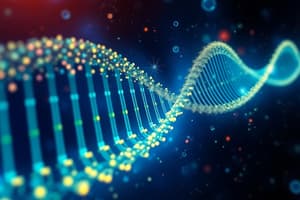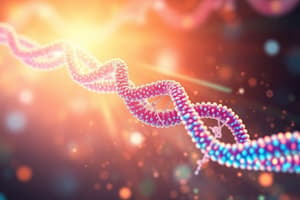Podcast
Questions and Answers
Why is sequence alignment a crucial step in bioinformatics analysis?
Why is sequence alignment a crucial step in bioinformatics analysis?
- It helps in measuring the similarity between sequences.
- It aids in observing regions of conservation and variability.
- It assists in predicting the function of new sequences.
- All of the above (correct)
Sequence alignment assumes that sequences do NOT share a common ancestor.
Sequence alignment assumes that sequences do NOT share a common ancestor.
False (B)
What type of alignment is used to compare only two sequences?
What type of alignment is used to compare only two sequences?
- Pairwise alignment (correct)
- Local alignment
- Global alignment
- Multiple sequence alignment
What does a dotplot provide?
What does a dotplot provide?
In a dotplot, rows represent residues from one sequence and columns represent residues from a different sequence.
In a dotplot, rows represent residues from one sequence and columns represent residues from a different sequence.
Why are gaps introduced during sequence alignment?
Why are gaps introduced during sequence alignment?
A negative score value called a ______ is used to penalize the creation of a gap in an alignment.
A negative score value called a ______ is used to penalize the creation of a gap in an alignment.
Which type of alignment compares sequences in their entire length and is useful for very similar sequences?
Which type of alignment compares sequences in their entire length and is useful for very similar sequences?
What does a local alignment seek to find?
What does a local alignment seek to find?
Local alignments are useful for finding conserved regions especially in distantly related sequences.
Local alignments are useful for finding conserved regions especially in distantly related sequences.
What type of alignment is suitable for comparing three or more sequences?
What type of alignment is suitable for comparing three or more sequences?
Match the symbols used in sequence alignment with their meanings:
Match the symbols used in sequence alignment with their meanings:
In sequence alignment, what does an asterisk (*) typically indicate?
In sequence alignment, what does an asterisk (*) typically indicate?
A colon (:) in a sequence alignment indicates that there are no similarities in properties between the amino acids.
A colon (:) in a sequence alignment indicates that there are no similarities in properties between the amino acids.
What is the primary purpose of alignment scoring?
What is the primary purpose of alignment scoring?
What is calculated by percentage sequence identity?
What is calculated by percentage sequence identity?
Percentage sequence identity is a complex scoring method.
Percentage sequence identity is a complex scoring method.
What does a substitution matrix provide in protein sequence alignment?
What does a substitution matrix provide in protein sequence alignment?
PAM and ______ are examples of protein sequence alignment algorithms that use complex scoring systems.
PAM and ______ are examples of protein sequence alignment algorithms that use complex scoring systems.
In alignment scoring, what is one of the factors that a substitution matrix is based on?
In alignment scoring, what is one of the factors that a substitution matrix is based on?
What is the purpose of gap penalties in sequence alignment scoring?
What is the purpose of gap penalties in sequence alignment scoring?
What does BLAST stand for?
What does BLAST stand for?
BLAST ignores local similarities between sequences.
BLAST ignores local similarities between sequences.
What is the primary function of BLAST?
What is the primary function of BLAST?
BLAST can identify evolutionarily ______ regions that are important for structure and/or function.
BLAST can identify evolutionarily ______ regions that are important for structure and/or function.
What does the E-value in BLAST results indicate?
What does the E-value in BLAST results indicate?
A lower E-value in BLAST results represents what?
A lower E-value in BLAST results represents what?
A high E-value in BLAST results indicates a high likelihood the match is significant and not due to random chance.
A high E-value in BLAST results indicates a high likelihood the match is significant and not due to random chance.
Which of the following BLAST programs is used to search a protein database using an amino acid sequence?
Which of the following BLAST programs is used to search a protein database using an amino acid sequence?
[Blank] is the most sensitive BLAST program that is useful for finding very distantly related proteins.
[Blank] is the most sensitive BLAST program that is useful for finding very distantly related proteins.
What type of sequence alignment is the Needleman-Wunsch algorithm used for?
What type of sequence alignment is the Needleman-Wunsch algorithm used for?
The Smith-Waterman algorithm is commonly used for Global alignment.
The Smith-Waterman algorithm is commonly used for Global alignment.
What is the use of TBLASTN?
What is the use of TBLASTN?
Match the BLAST program to the corresponding description.
Match the BLAST program to the corresponding description.
Flashcards
Sequence Alignment
Sequence Alignment
A process that finds the order of a set of sequences to maximize their similarity.
Sequence Similarity
Sequence Similarity
Sequence analysis that seeks to quantify the degree to which two or more sequences are related or identical.
Why Align Sequences?
Why Align Sequences?
Aligning sequences to measure similarity, observe conservation, determine residue correspondence, and predict function.
Origin of Sequence Similarity
Origin of Sequence Similarity
Signup and view all the flashcards
Pairwise Alignment
Pairwise Alignment
Signup and view all the flashcards
Dotplot
Dotplot
Signup and view all the flashcards
Global Alignment
Global Alignment
Signup and view all the flashcards
Local Alignment
Local Alignment
Signup and view all the flashcards
Multiple Sequence Alignment (MSA)
Multiple Sequence Alignment (MSA)
Signup and view all the flashcards
Asterisk (*) in Alignment
Asterisk (*) in Alignment
Signup and view all the flashcards
Colon (:) in Alignment
Colon (:) in Alignment
Signup and view all the flashcards
Full Stop (.) in Alignment
Full Stop (.) in Alignment
Signup and view all the flashcards
Alignment Scoring
Alignment Scoring
Signup and view all the flashcards
Percentage Sequence Identity
Percentage Sequence Identity
Signup and view all the flashcards
Substitution Matrix
Substitution Matrix
Signup and view all the flashcards
Gap Penalty
Gap Penalty
Signup and view all the flashcards
BLAST
BLAST
Signup and view all the flashcards
What is BLAST?
What is BLAST?
Signup and view all the flashcards
BLAST Use Cases
BLAST Use Cases
Signup and view all the flashcards
Conserved regions in BLAST
Conserved regions in BLAST
Signup and view all the flashcards
Study Notes
- Bioinformatics II focuses on Alignment & Similarity.
Learning Objectives
- Sequence analysis encompasses alignment and similarity assessments.
- Alignment methods are employed to align sequences, and their effectiveness is evaluated through alignment scoring.
- Homology searches, particularly using BLAST, are conducted to identify related sequences.
Why Align Sequences?
- Sequence alignment enables the measurement of similarity between sequences.
- It allows for observation of regions of conservation and variability.
- It helps determine residue-residue correspondences and predict the function of new sequences, which is invaluable for genome annotation.
Sequence Alignment and Common Ancestry
- Sequence similarity often suggests a common evolutionary origin.
- Aligning sequences presumes a shared ancestor, indicating homology.
- Protein sequences evolve, and alignments pinpoint homologous positions.
Pairwise Alignment
- Pairwise alignment compares two sequences, usually visualized using a dotplot matrix.
- Dotplots offer an overview of similarities between two sequences, with rows and columns corresponding to residues in each sequence.
Dotplots
- Dotplots are simple matrix representing the similarity between sequences
- Rows and columns represent a sequence each
- In a dotplot, if two sequences are identical, a diagonal line appears.
- Differences appear as interruptions or shifts in the diagonal.
Gaps in Alignments
- Gaps are insertions or deletions introduced to improve alignment matching.
- Gaps influence alignment scoring.
Global Alignments
- Global alignments compare sequences in their entirety and are useful for short, similar sequences.
- An example tool is NEEDLE, employing the Needleman-Wunsch algorithm.
Local Alignments
- Local alignments identify regions of highest similarity and extend the alignment outward.
- Conserved regions in distantly related sequences are found through this method usually.
- The WATER tool uses the Smith-Waterman algorithm.
Multiple Sequence Alignment (MSA)
- Multiple sequence alignment (MSA) compares three or more sequences.
- CLUSTAL is an example of MSA algorithms.
Features of Sequence Alignment
- Accession numbers provide an entry point into a database
- Gaps represent insertions or deletions within a sequence alignment.
- Consensus symbols, such as asterisks, colons, and full stops, denote levels of conservation
Amino Acid Properties
- Asterisks indicate fully conserved residues, colons indicate conservation between strongly similar groups, and periods indicate conservation between weakly similar groups
Alignment Scoring
- Alignment scoring is essential and influenced by:
- Sequence composition
- The aim is to score the similarities and differences between sequences
- Gaps are often penalized, as this can affect the alignment score
Percentage Sequence Identity
- Percentage sequence identity indicates variance.
- Gaps (insertions/deletions) affect sequence identity.
Complex Scoring Systems
- Protein sequence alignment algorithms use PAM or BLOSUM.
- Numerical scores are derived from substitution matrices to specific amino acid pairings.
- Known mutations impact the score derived from substitution matrices when scoring
- Biochemical similarity and the probabilty of occurance are also factors
- Score is based on what alignment is using for the process
Gaps and Penalties
- Gaps must be accounted for, with "gap penalties" used to avoid unchecked gaps and nonsense alighments.
- Gap creation is penalized with negative scores.
BLAST
- Basic Local Alignment Search Tool locates regions of local similarity between nucleotide or amino acid sequences.
- BLAST enables comparison of a query sequence against a database, identifying similar sequences by finding regions of similarity with local alignments.
- You can identify evolutionarily conserved regions
- You can find regions of common structure and function
- BLAST can find evolutionarily conserved regions for structure and/or function.
- These regions are often strictly required.
BLAST Results
- It identifies unknown sequences and find homologous sequences.
Types of BLAST Searches
- BLASTP: Amino acid sequence against protein sequences.
- BLASTX: Translated nucleotide sequence against protein sequences.
- TBLASTN: Amino acid sequence against translated nucleotide sequences.
- TBLASTX: Translated nucleotide sequence against translated nucleotide sequences.
- BLASTN: Nucleotide sequence against nucleotide sequences.
- PSI-BLAST is the most sensitive program and useful for finding very distantly related proteins
Key Summary Points
- Sequence similarity and alignment is central to bioinformatics analysis
- Global alignments are best for short and similar sequences
- Local alignments are used for finding regions of homology
- A BLST tool assists in finding unknown sequences, or evolutionarily conserves regions.
- Choosing a BLAST program depends on use case.
Studying That Suits You
Use AI to generate personalized quizzes and flashcards to suit your learning preferences.




